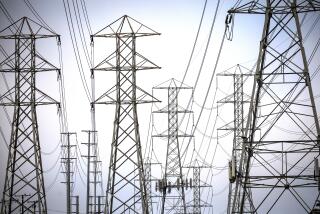Consumers : Rating Energy Use of Home Appliances
- Share via
In just a few years, Americans will be conserving more energy in home appliance use than ever before, thanks to the National Appliance Energy Conservation Act.
Signed into law in 1987, the legislation mandates federal standards for a wide range of home appliances. The new standards will kick in between now and 1993, depending on the appliance, but manufacturers began this year to redesign products to make them 15% to 25% more efficient.
By all accounts, what this will mean for consumers is appliances that are a lot less expensive to run. Experts project a net savings nationwide of $28 billion through the year 2000, or almost $300 per household.
But consumers shopping for new appliances still need to know how to read the yellow Energyguide stickers on home appliances, and interpret the information for the maximum economic benefit.
Given the cost of energy in your area, how much will you save over the life of a particular appliance? You’re thinking of buying the most energy-efficient refrigerator: When will your energy-related savings make up for the generally higher purchase price?
(Californians may not notice that much of a difference--unless they happen to have a 15-year-old refrigerator imported from some other state--because the state already has the toughest energy efficiency standards for home appliances anywhere in the nation.
(“The federal government used California as a model for its standards,” noted California Energy Commission spokeswoman Susan Patterson.)
Know Local Rates
First, say consumer experts, you need to know what you are paying in your area for electricity and gas. Then you can calculate your basic rate against the chart on the Energyguide to see about how much you would save on a particular model of a particular appliance.
The Energyguide will show what the model you are considering will cost, compared to a model with the highest energy cost and one with the lowest. The comparisons are made between same-size appliances, and taking into consideration different brands, not just the one you are considering. The guide will not tell you, though, which brands are listed as most or least energy saving.
For instance, the Energyguide might say that the 22.2-cubic-foot refrigerator you’re considering will cost you an estimated $87 a year to operate, compared with $80 for the most efficient and $121 for the least efficient.
Although the model that is most energy efficient will probably cost you more to purchase up front, energy experts say you will be able to save more than the difference over the lifetime of the product. In some cases, you may recoup the difference in the first year.
“If one freezer is $500 and the other, more energy efficient one is $750,” noted Nick Fedoruk, director of the Energy Conservation Commission in Washington, “that’s $250 more in initial cost, but you will, with the energy efficient one, save more than $50 on your electric bill in a year. In five years, you’ll have saved the $250, and anything after that in the life of the appliance is more saving of money and electricity.”
Another variable is the cost of energy in your area. The energy costs projected on the stickers are based on U.S. government standard tests, which use a national average electric rate of 7.63 cents per kilowatt-hour and a natural gas rate of 62.7 cents per therm. Yours may be higher or lower.
In the Los Angeles area, for example, rates are different depending on whether your electricity is supplied by the Department of Water and Power (DWP) or Southern California Edison.
The electric rate for customers of the DWP is revised every quarter to reflect the “flow-through energy cost adjustment”--meaning how much it costs the DWP to purchase hydroelectric power or burn oil to generate electric power.
DWP’s rate averages about 8.5 cents per kilowatt-hour over a year, according to the DWP’s Ed Freudenburg.
Wet Winter Lowers Rates
“If we have a wet winter and can generate more hydroelectric power, then the rate goes down. If not, and you have to burn a lot more oil, then we have to raise the rate and the cost to the consumer goes up,” Freudenburg added.
Southern California Edison representatives say that the utility’s rates for residential customers averaged about 8.5 cents per kilowatt-hour as of April.
Residential appliances that use the most electricity per year are forced-air heating and cooling systems, according to Jan Barnett, an energy management analyst for Southern California Edison. And “if you don’t have electric air conditioning, then usually the greatest user is the refrigerator because it runs all the time,” she said.
As far as gas energy costs go, the Southern California Gas Co. doesn’t charge a flat rate per therm; instead, rates vary according to the time of year, said spokesman Rich Puz.
Puz explained that the current rate from November through April is 62 base line therms at 35.9 cents per therm. After 62 therms, you pay 77.3 cents a therm.
Gas More Economical
Gas appliances, however, still seem to be to be more economical to use than electric ones.
A 40-gallon gas home water heater costs about $104 a year to operate; electric about $409 per year, according to gas and electric company statistics. But with gas, you will have to add the cost of having a vent installed to the outside of your home, and perhaps a gas line or line extension put in for the heater, which could be a considerable one-time expense.
Energy costs on some appliances can affect others. What kind of water heater you buy also will affect the cost of running your clothes washer. If you’re buying a clothes washer, check the Energyguide for its estimates of what it will cost to operate the washer with gas and electric water heaters.
Based on local rates, for instance, it would cost about $9 a year to do two loads of wash a week in a standard-size clothes washer with water from a gas water heater. With an electric water heater, it would cost about $21.
Home appliances--refrigerators, freezers, air conditioners, furnaces, clothes washers and dryers, dishwashers, ovens, ranges, TV sets, water heaters, dehumidifiers, humidifiers, gas space heaters, heat pumps, and swimming-pool heaters--account for 24% of the electricity consumption in the United States every year, Fedoruk said.
“And that figure does not include lighting,” he said. “Currently we’re working on standards for incandescent and fluorescent lamps. . . . In a sense, what we’re doing is saving the consumer from his ignorance.”
More to Read
Inside the business of entertainment
The Wide Shot brings you news, analysis and insights on everything from streaming wars to production — and what it all means for the future.
You may occasionally receive promotional content from the Los Angeles Times.










